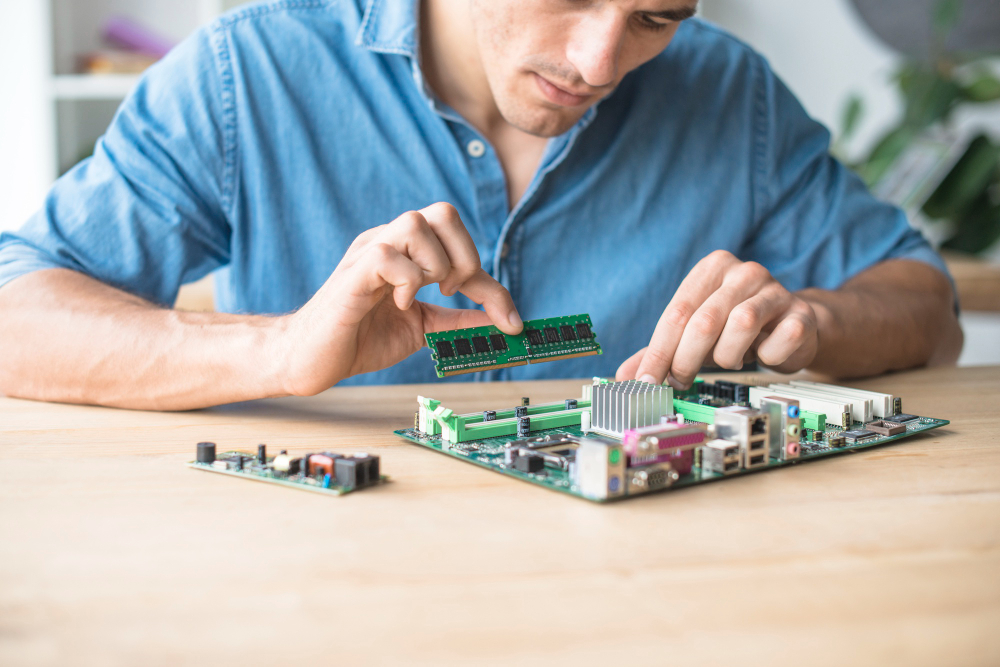Design Considerations for High-Power, Multi-Source PCBs

While the provided “Energy Fusion Core” PCB is a conceptual layout with simplified traces and component placement, real-world implementation of such a high-power, multi-source system would necessitate numerous critical design considerations. These encompass aspects like PCB layout and construction, thermal management, Electromagnetic Interference (EMI) and compatibility (EMC) mitigation, and addressing power density challenges.
- PCB Layout and Construction: The physical design of the PCB is fundamental to the system’s performance and reliability.
- High-Current Traces: Paths carrying significant current—from the input conditioning units (U1_GRID_PROC, U2_SOLAR_MPPT, U3_TURB_PROC) to the EFC_X1, along the “Direct Charging DC Bus,” and to the EV controller modules (U_EV_CTRLx)—must be meticulously designed. This involves using copper traces of adequate width and thickness (referred to as heavy copper) to handle large continuous and peak currents with minimal resistive (I²R) losses and associated voltage drops. The conceptual design indicates these paths with a “power-trace” class.
- Layer Stack-up: A multi-layer PCB construction will be essential for such a complex system. Inner layers are typically dedicated to solid power planes (for +VCC and GND) and ground planes. These planes provide low-impedance paths for current distribution, help reduce EMI by providing a good reference and shielding, and can also aid in heat dissipation. The number of layers will depend on routing density and isolation requirements.
- Component Placement: Strategic placement of high-power components (like the EFC_X1 module, input power conditioners, and EV charger modules) and heat-generating components (power semiconductors, magnetic components) is crucial. They should be positioned to facilitate effective heat dissipation, minimize the length of high-current traces, and maintain adequate separation between noisy power sections and sensitive control circuitry (like U_MCU_SYS_CTRL and its associated analog and digital signals) to prevent interference.
- Vias: Appropriate via design (including through-hole vias, and possibly blind or buried vias for very high-density designs) is essential for connecting traces between different layers, especially for power and ground paths. The current-carrying capacity and thermal properties of vias must be considered. The conceptual PCB shows some vias connecting components to the main DC bus.
- Mounting Holes: The provided mounting holes are necessary for securing the PCB within an enclosure, providing mechanical stability, and often serving as connection points for chassis grounding.
- General PCB Design Principles: Adherence to established PCB design guidelines regarding trace spacing for voltage isolation (creepage and clearance), controlled impedance for high-speed signal lines, and proper grid systems for component placement is vital for manufacturability and operational integrity.
- Thermal Management: High-power electronic systems like the EFC charger generate significant amounts of waste heat, primarily due to switching and conduction losses in semiconductors and losses in magnetic components. Effective thermal management is critical to maintain component temperatures within safe operating limits, ensure system reliability, and prevent premature failure.
- Heat Dissipation Strategies: A multi-faceted approach to heat dissipation will be required:
- Heat Sinks: Power semiconductors (MOSFETs, IGBTs, diodes) in the input conditioners, EFC_X1, and EV charging modules will almost certainly require appropriately sized heat sinks.
- Thermally Conductive Materials: Using PCB substrates with enhanced thermal conductivity or incorporating Thermal Interface Materials (TIMs) like thermal pads or grease between heat-generating components and heat sinks/chassis can improve heat transfer.
- Thermal Vias: Arrays of thermal vias can be placed underneath surface-mounted power components to conduct heat away from the component to inner copper planes or to a heat sink on the opposite side of the PCB.
- Forced Air/Liquid Cooling: Depending on the overall power density and ambient conditions, forced-air cooling (using fans) or even liquid cooling may be necessary for the highest power modules, especially the EFC_X1 and individual EV charger stages [(DCFC cooling unit)].
- Potting and Encapsulants: For magnetic components (inductors, transformers) and power modules, thermally conductive potting compounds or encapsulants can improve heat transfer to a cooling plate or heat sink, while also providing mechanical support and environmental protection. Thermal gap fillers can be used to fill air gaps between irregularly shaped components and heat sinks.
- Phase Change Materials (PCMs): For passive thermal regulation of critical components or to buffer transient heat loads, PCM-based solutions could be explored. PCMs absorb and release heat at nearly constant temperatures during phase transition, which can help stabilize component temperatures.
- EMI/EMC Mitigation: The inherent high-frequency switching in power electronic converters (AC-DC rectifiers, DC-DC converters) makes them significant sources of Electromagnetic Interference (EMI). Ensuring Electromagnetic Compatibility (EMC)—that the system does not interfere with other equipment and is not susceptible to external interference—is a regulatory requirement and crucial for reliable operation.
- Mitigation Techniques:
- Grounding and Shielding: A well-designed grounding scheme (e.g., single-point or star grounding for different sections) is fundamental. Shielding of noisy modules or the entire enclosure (Faraday cage principle) can contain radiated EMI and protect against external fields.
- EMI Filters: Robust EMI filters (comprising inductors, capacitors, and common-mode chokes) will be needed for input and output power lines to suppress conducted emissions and improve immunity to conducted disturbances.
- PCB Layout for EMI Control: Careful PCB layout is paramount. This includes minimizing the area of high-frequency current loops (which act as antennas), ensuring short and direct return paths, effectively utilizing ground planes, and maintaining separation between power traces (especially switching nodes) and sensitive analog or digital signal traces.
- Decoupling Capacitors: Placing decoupling capacitors close to the power pins of Integrated Circuits (ICs) and other active components helps suppress high-frequency noise and stabilize local power rails.
- Component Selection: Choosing components with inherently lower EMI emissions or higher immunity can simplify EMC compliance.
- Power Density Challenges and Solutions: Modern EV chargers, especially multi-port DC fast chargers like the conceptual EFC system, strive for high power density (more power output in a smaller volume/weight). This presents significant design challenges.
- Achieving High Power in Limited Space: Integrating multiple input conditioning stages, a central EFC_X1, multiple EV charging modules, and control circuitry into a compact form factor is a primary challenge.
- Wide-Bandgap (WBG) Semiconductors: The adoption of WBG power devices like Silicon Carbide (SiC) and Gallium Nitride (GaN) is a key enabler for higher power density. Compared to traditional Silicon (Si) MOSFETs or IGBTs, WBG devices offer lower conduction and switching losses, can operate at much higher switching frequencies (allowing for smaller passive components like inductors and capacitors), and can withstand higher operating temperatures. The EFC_X1 and other high-frequency power conversion stages would be prime candidates for WBG technology.
- Advanced Converter Topologies and Integration: Utilizing advanced power converter topologies, such as multi-level converters or resonant converters, can improve efficiency and reduce the size of magnetic components. Furthermore, integrating multiple power stages into a single module or reducing the number of isolated power rails through innovative gate driver technologies (e.g., integrating bias supplies) can lead to more compact designs.
- Mitigation Techniques:
- Heat Dissipation Strategies: A multi-faceted approach to heat dissipation will be required:
The conceptual nature of the PCB, with its “simplified traces and component placement,” effectively masks the immense real-world difficulties that would be encountered in routing high-current, high-voltage power traces alongside sensitive, low-voltage control signals (such as those critical for U_MCU_SYS_CTRL and the EFC_X1), especially if all were to be implemented on a single, large PCB. In a practical high-power system, managing EMI, cross-talk, and thermal hotspots would be a formidable task. Physical partitioning of the system, perhaps into multiple interconnected PCBs or modules (e.g., separate shielded power modules for each input and output stage, connected via robust busbars or short, shielded cables to a central control board), is a more conventional and often necessary approach to ensure signal integrity and effectively manage thermal loads in such a complex, high-power environment.
Moreover, the decision to employ WBG semiconductors (SiC/GaN), while highly advantageous for achieving greater power density and efficiency, introduces its own set of design considerations. These devices typically require specialized gate driver circuits capable of delivering fast switching edges and precise gate voltage control, which can differ significantly from drivers for traditional silicon devices. While WBG devices can operate at higher junction temperatures, their often smaller die sizes can lead to higher heat flux densities, meaning thermal management remains a critical concern, albeit with potentially different optimal solutions (e.g., direct liquid cooling or advanced TIMs). The currently higher cost of WBG components compared to their silicon counterparts would also be a factor in the overall system cost, influencing trade-offs between performance, size, and affordability.
Team
Our Driving Force - Our Dedicated Team
The success of “Shead Green Mobility and Renewable Technology OPC” is rooted in the collective efforts of a group of talented, enthusiastic, and dedicated individuals. Each member of our team is experienced in their respective fields and deeply committed to the company’s goals and philosophy. Besides the founder, our team includes technologists, engineers, marketing experts, and skilled managers who are working tirelessly to turn this green mobility revolution into reality.

MD Mohiminul Islam Shead
He is the hero behind "Shead Green Mobility and Renewable Technology private limited company"

Professor Dr. Md. Nurul Amin
Professor Dr. Md. Nurul Amin stands as a pivotal figure and visionary co-founder of Shead Green Mobility and Renewable Technology OPC (SMRT)

